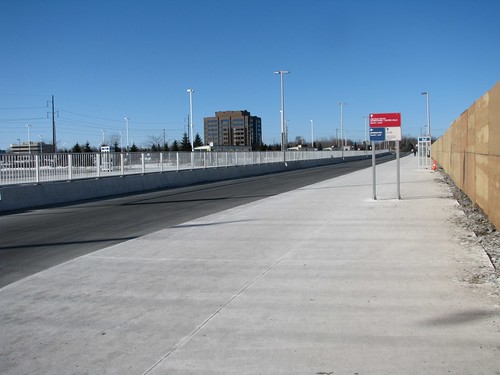
I was visiting Baseline Transitway Station recently and had that sudden feeling of dislocation you get when what you see in front of you is very different than what your eyes have been trained to expect. In a flash a new fact was driven home: the place is no longer what it was when I first visited in the fall of 1985.
Nor is it anything like what it is expected to be in a year’s time.
Right now, it’s a great deal of open space.
From April to November, that may yet be a good thing. But in the dead – or perhaps not so dead in these days of fears of climate derangement? – of an Ottawa winter, such a space may seem more desolate than it truly is.
Looking back, I remember Baseline as it was, one of the first examples of a Transitway station I’d ever seen. Newly arrived in Ottawa with my parents and siblings in 1985, I was beginning my first run of the Algonquin College system as a student in business administration, training in what was hoped to be “fallback” skills in case the big dream fell through. Having spent much of my life in the prairie cities, I had no acquaintance with what a “transit city” like Ottawa would be like.

Baseline Station as it was – photo by Steve Brandon
Baseline as it once was…was young, then. Newly built, barely finished before my family’s arrival. It was all scarlet metal tubes and framers, tinted glass and plastic and concrete bunkers. An exemplar of all the Transitway stations to come, from one end of the region to the other.
The other stations were barely there at first. Hurdman, Iris and Lincoln Heights were up and running as well, but that was about it for the stations built in what has come to be known as the Transitway architectural “signature” style. Lebreton, St. Laurent and Place d’Orléans were there, but only just. Prefab portable shelters, concrete kerbs and asphalt hived off from parking lots mostly. The rest of the network wasn’t in place yet so far as I can remember.
There were no convenience stores yet in any of the stations. Whatever retailers and restaurants were near each of the stations was expected to serve such needs. Services came much later in the game.
Nor was Ottawa what it is today. OC Transpo served the Regional Municipality of Ottawa-Carleton, not the City of Ottawa. The RMOC was a patchwork of cities, towns and a few villages thrown together within the bounds of the present-day City. Those municipalities sometimes co-operated and sometimes fought, depending on how they saw as their needs at the moment. Mike Harris put an end to that in 2001 during his tenure as Ontario Premier.
As for Algonquin College, it too has gone through changes. The college has grown by leaps and bounds, despite spinning off the French-language services and courses into La Cité collégiale in 1990, and selling off assorted satellite campuses to other institutions across the city. Also, thanks to that “shotgun marriage” in 2001 mentioned a little while ago, the campus is no longer in Nepean – which no longer exists for the province’s purposes – but Ottawa.
And now the station to be is set to be something not unlike the present set-up of St. Laurent and Riverside Stations. Part and parcel of the campus itself, even though maintained by OC Transpo as though separate from the rest of Algonquin. The building is not yet in place, and so we have this in the meantime:
A quarter-century’s differences. And time keeps moving, our needs along with them.


2 comments
So…Baseline station was an empty windswept wasteland 25 years ago, is still an empty windswept wasteland, but may be less of an empty windswept wasteland real soon now. Move along folks…nothing to see here…
Empty windswept wastelands seem to be this duckburgh’s preferred location for transit facilities. (Cf. Lincoln Fields, Hurdman, Fallowfield, the afterthought-to-a-parking-lot Place d’Orleans, etc., etc., etc.